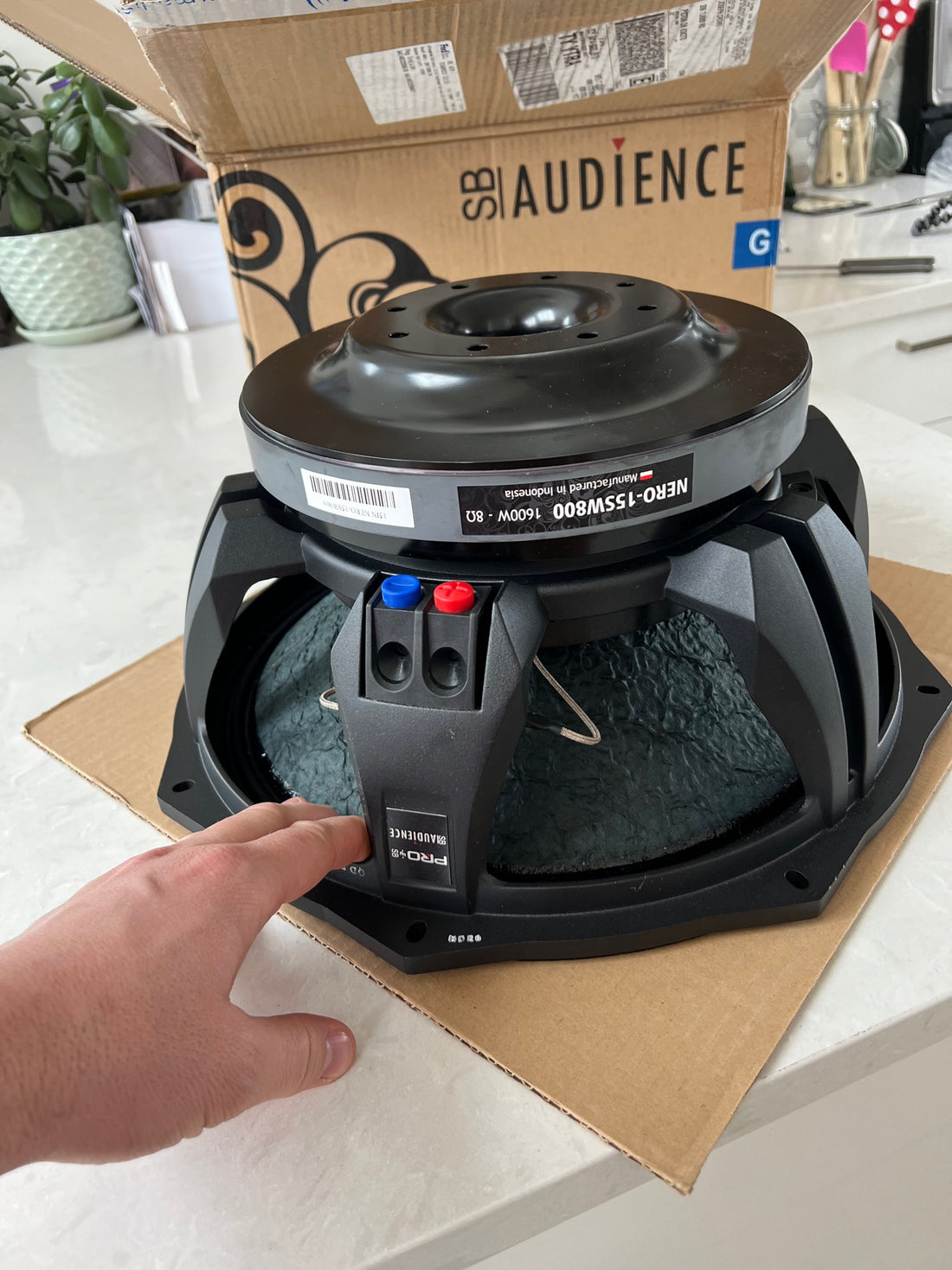Please check out my other blog posts here.
In this blog post I test the SB Audience Nero 15SW800 with Cabinet No.1798.
Features
- 4.5" voice coil
- Aluminum Demodulating Ring
- Double spider
- 96dB Sensitivity
- 8 ohm
- 14.27mm xmax
- 38mm peak to peak
- 800w (1600w Max) power handling









Cabinet No.1798 is a 275L front horn bass reflex cabinet with a 34Hz tuning frequency. Using Vituix we get the following dashboard for 1w input power. (click to enlarge)
We see bass extension to 40Hz and a somewhat uneven impedance alignment.
Increasing the simulation input power to the rated 800w reveals the following...
Here is a summary of what we see in the simulation:
- Port velocity well below limit (port noise not an issue)
- Maximum SPL 1m is 120.6dB
- Cone excursion peaks out at 30.4Hz
- Group delay below 30ms peaking at 33Hz.
Actual Test Results
Below is the impedance sweep as measured with my 1798 bass cabinet. We can see that the alignment is much happier than the simulation would suggest. This is why it's always important to build at least one test box. Generally I find that one or two test boxes are required when optimal sound quality is the goal since the simulations are never truly accurate.
Frequency Response (indoors)
Below is the frequency response indoors. The response starts strong at 36Hz with a rising response starting at 100Hz. There is a small peak at 290Hz which also shows up in my impedance sweep. Above 300Hz the response falls quickly and is down -15dB at 500Hz. This is ideal if wanting a steep filter at 500Hz and reduces the complexity of the crossover.
Burst Decay
The burst decay shows some stored energy at the 290Hz region, but otherwise it is well behaved.
Distortion
I tested harmonic distortion at 85, 95, and 105dB SPL at 1m. Below is the result for the 85dB test signal. These numbers are similar to the TAD TL-1601B.
Harmonic Distortion at 100Hz (85dB-C, 1m)
H2: 0.05%
H3: 0.26%
H4: 0.07%
At the 95dB test signal level we see slightly higher harmonic distortion figures compared to the TAD TL-1601B, but still commendably low.
Harmonic Distortion at 100Hz (95dB-C, 1m)
H2: 0.31%
H3: 0.33%
H4: 0.01%
Harmonic Distortion at 100Hz (105dB-C, 1m)
H2: 1.74%
H3: 0.48%
H4: 0.11%
Intermodulation Distortion
85dB sees IMD at -60dB across the woofer's passband with IMD staying consistently low across the frequency spectrum. This could not be said for the Beyma 15LX60V2 or TAD TL-1601B where we saw some erratic IMD noise profiles from each driver.
95dB sees IMD rise to -50dB which is similar to what I saw with the TL-1601B.
Gedlee Metric Distortion (Gm)
Using my Virtins Multi-Instrument software, I acquired the Gm distortion using a 100Hz sine tone test signal at 85dB and 95dB.

These numbers will be more contextual as I collect Gm on future tests. But for now, I am consistently seeing an inverse relationship between THD and Gm, with Gm increasing at higher SPL, while THD is lower at higher SPL. This further delegitimizes THD as a relevant metric for sound quality.

Subjective Listening Impressions
In a stereo pair in my large listening space the woofers had a balanced sound in terms of low bass, mid-bass, and lower midrange (up to 500Hz). The low bass (30Hz region) shook the floor and my chair more than I was expecting. The mid-bass had great punch that you could feel through your body and sounded acceptably 'fast'. The lower midrange was clear and uncolored. The woofer had a great ability to transmit punch and dynamics even at low listening levels. At higher listening levels the woofer did not sound strained in any way, even at 107dB at my listening chair 3m away.
Comparing the 15SW800 to the recently testing Beyma 15LX60V2 I found that I slightly preferred the sound character of the 15SW800 for it's agility on bass transients, particularly low bass frequencies in the 30Hz region. However I would be happy with either driver.
The sharp falling response above 300Hz also meant that I did not have to fight with the driver when developing a low pass filter.
I would be happy to recommend the SB Audience Nero 15SW800 Subwoofer.










